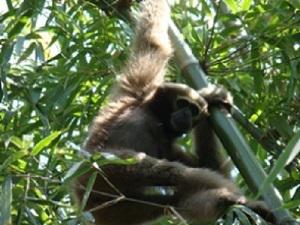Divya Vasudev
The aim of the project is to determine the influence of factors of conservation relevance, such as fragment size, shape, isolation and surrounding matrix on primate occupancy in community-owned forest fragments.

Fragmented Landscape.
Forests in Garo Hills exist largely as small fragments that harbour endangered wildlife, but are steadily being lost to agricultural practices. Non-governmental organisations have formalized vanishing traditions of forest conservation by demarcating community-managed forest reserves in villages and simultaneously engaging in restoration activities within and adjoining the reserves. However, there is little ecological knowledge on the population status and dynamics of focal species. I propose to aid conservation planning though an evaluation of drivers of occupancy patterns of primates, a focal species for conservation.

Hoolock Gibbon Female.
The specific aims are as follows: (a) to investigate if factors that can aid in fragment prioritization, such as fragment size, shape and distance from identified source populations influence primate occupancy patterns; (b) to assess the influence of canopy connectivity within fragments on probability of occupancy; and (c) to evaluate the influence of surrounding land-use on occupancy patterns. I will address my goal through occupancy surveys within forest fragments, recording presence of the western hoolock gibbon Hoolock hoolock, capped langur Trachypithecus pileatus and stump-tailed macaque Macaca arctoides. Five temporal replicates will allow for the estimation of detection probability. Each fragment will be associated with a capture history of detection for each species, an estimate of fragment size, distance from Nokrek National Park and the nearest occupied fragment, indices of fragment shape and canopy connectivity and a categorical variable determining the dominant land-use type surrounding the fragment.
I will test the influence of single or a combination of above-listed factors on the probability of occupancy of each species within software PRESENCE. The key outcomes of the proposed project include: (1) Identification of factors of importance to occupancy patterns of primates to aid forest fragment prioritization strategies; (2) Assessment of the influence of fragment area and canopy connectivity on primate occupancy to inform restoration activities; and (3) Comparison of relative benefits of existing land-uses to primate occupancy patterns to benefit land-use planning and conservation education activities. To maximise conservation applicability, I am collaborating with Wildlife Trust of India, an organisation involved in an ongoing conservation programme in the landscape. The scientific advisor of the project is Dr. Robert J. Fletcher Jr., University of Florida.